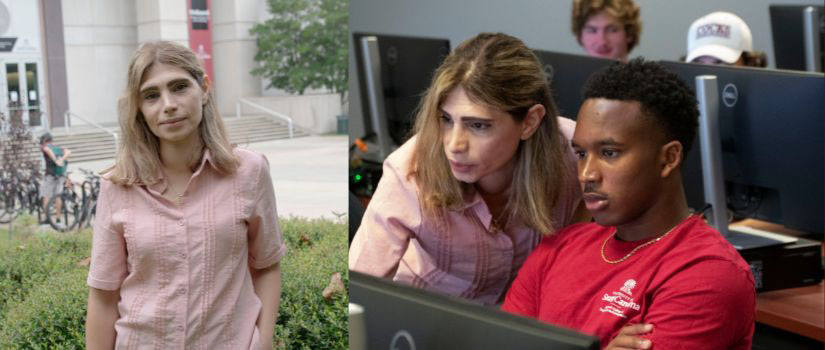Biomedical engineering can be described as impacting patient care by improving treatment outcomes and quality of life for patients. These improvements are critical since the Centers for Disease Control found that 83.4% of adults visited a doctor or other health care professional in 2022.
Instructor Azadeh Sepahvandi's journey into biomedical engineering was motivated by a desire to positively impact human health. She wanted to follow in her father’s footsteps, a professor and doctor, and someone who had a strong influence encouraging her and her siblings to pursue education.
“He loved being a physician, but I didn’t see myself engaging directly with patients. However, I always had a passion for health, which led me to biomedical engineering,” Sepahvandi says.
Sepahvandi’s academic path began in Iran, where she earned her bachelor’s, master’s and Ph.D. in biomedical engineering/biomaterials from Polytechnic University in Tehran. After working as a research specialist for a year at the university, she moved to the U.S. in 2017 to become a postdoctoral researcher at the Molinaroli College of Engineering and Computing. Reflecting on this transition, she highlighted the global language of science.
“There isn’t a big difference between academic efforts around the world. If you have passion, you can do it anywhere. The support and encouragement I received in the U.S. allowed me to continue my work here,” Sepahvandi says.
Her research interests primarily focus on tissue engineering, a discipline of biomedical engineering to restore, maintain or improve damaged tissues or whole organs. Sepahvandi is particularly interested in the potential of using non-chemical signals like light and sound, which are often overlooked, to positively influence tissue regeneration and human health.
One of her key projects focuses on using luminescent nanoparticles in tissue regeneration by studying how emitted light can support the healing process. Another project explores the regeneration of cartilage using natural substrates derived from articular cartilage, which she believes could have significant applications in regenerative medicine. Sepahvandi is excited about integrating artificial intelligence and mathematical modeling in biomedical research.
“The most interesting current trend is combining experimental work with mathematical models. This helps us communicate our results more effectively and ensures that our findings are reliable and accurate,” Sepahvandi says. “This combination is essential for the advancement of biomedical engineering.”
Sepahvandi is also working on proposals for research on tissue engineering in microgravity. She hopes her work will lead to breakthroughs that are not possible under Earth’s gravitational conditions, particularly in the field of retinal tissue engineering.
“Retina degeneration often leads to blindness, and I hope to one day make significant progress in this area. The microgravity environment could open new doors for successful research,” Sepahvandi says.
Beyond her research, Sepahvandi is also passionate about teaching. Currently an instructor in the Department of Mechanical Engineering, she teaches courses to over 150 students (primarily freshmen) each semester. She strives to foster creativity and encourages her students to take an active role in their learning.
“Almost all my students enjoy my classes because I encourage them to apply creativity. It’s not just about following rubrics; it’s about allowing them to create something unique, which makes a big difference,” Sepahvandi says.
Sepahvandi’s dedication to research and teaching has earned her numerous accolades, such as her selection as one of the top 10 winners at the 2016 iBRIDGES Berlin Innovation Festival and best Ph.D. theses among all university majors in 2016 at Polytechnic University. Yet, the accomplishment she is most proud of is the U.S. patent she earned during her time as a master’s student.
“That was a big success for me. I was living in Iran at the time, and my hypothesis received attention at an international conference in the U.S. It’s something I’m still proud of,” Sepahvandi says.
With a career spanning groundbreaking research and impactful teaching, Sepahvandi continues to inspire those around her with a dedication to advancing biomedical engineering. Her commitment to research, combined with a passion for mentoring young engineers, solidifies her role as both a trailblazer and a teacher.
"We should never stop learning, and that’s the mindset I aim to instill in my students," Sepahvandi says. "The goal is not just to teach content but to inspire students to think creatively and solve problems."
